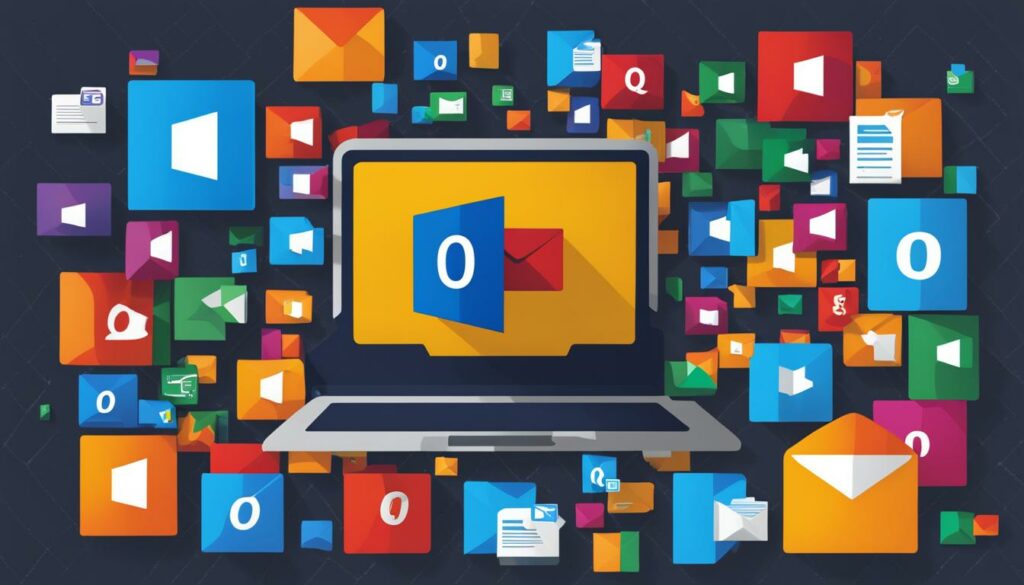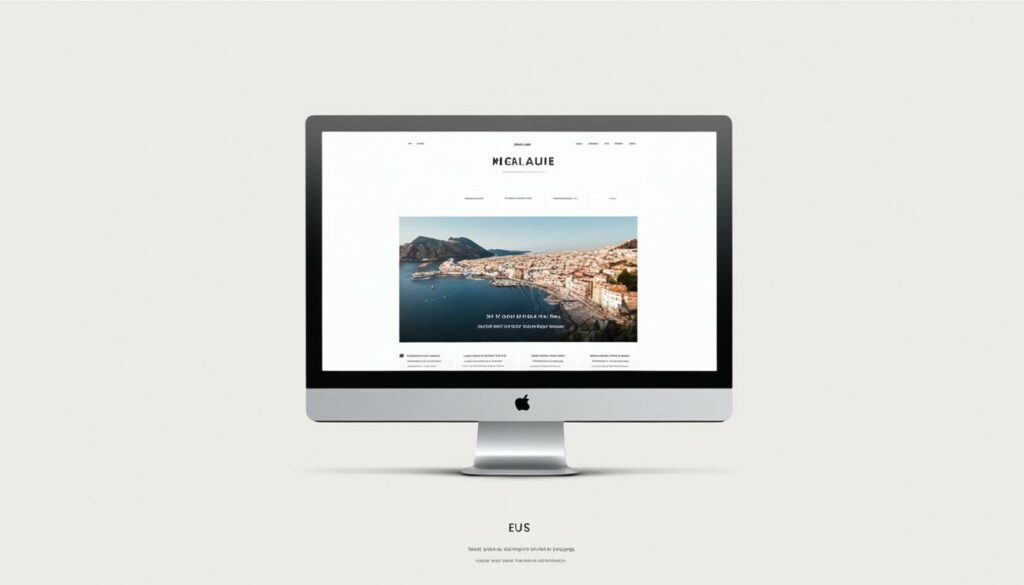Are you tired of using the same old email client and looking for alternatives to Microsoft Outlook? While Outlook is a popular choice for many, there are several other email clients out there that offer different features, pricing options, and user experiences. In this article, we will explore 11 Outlook alternatives and help you determine if they are suitable options for you.
When it comes to email clients, one size doesn’t fit all. Each client has its own unique set of features and benefits. Whether you’re seeking simplicity, advanced customization, or enhanced productivity, there’s an email client out there that’s perfect for you. Let’s dive into the world of Outlook alternatives and find the one that meets your needs.
Key Takeaways
- Explore 11 Outlook alternatives to find the right email client for you.
- Consider your specific needs and preferences when choosing an email client.
- Features, pricing options, and user experiences vary among different email clients.
- Popular alternatives to Outlook include Thunderbird, Gmail, and eM Client.
- Find an email client that enhances your productivity and meets your requirements.
The Overview of Microsoft Outlook
Microsoft Outlook is more than just an email client. It offers a wide range of features that go beyond sending and receiving emails. With Outlook, you can efficiently manage your schedule, stay organized with tasks and notes, and even browse the web without leaving the application. Let’s take a closer look at the history and key features of Microsoft Outlook.
History of Microsoft Outlook
Microsoft Outlook has a long history that can be traced back to the release of Microsoft Office 97. It replaced two previous Microsoft applications, the Microsoft Exchange Client and Microsoft Schedule+. Over the years, Outlook has evolved and adapted to meet the changing needs of users.
In 1997, Microsoft introduced the web-based version of Outlook known as Outlook on the Web, originally called Outlook Web Access. This allowed users to access their Outlook accounts from any web browser, bringing more flexibility to their email experience. Additionally, in the same year, Microsoft acquired Hotmail, which later transformed into Outlook.com.
Today, Microsoft Outlook has grown to become one of the most popular email clients with over 400 million active users. It is available not only as a desktop application but also as a web-based and mobile version, providing users with seamless access across different devices.
Key Features of Microsoft Outlook
Microsoft Outlook offers a comprehensive set of features that make it a powerful tool for managing emails and more. Some of the key features include:
- Email Management: Outlook allows you to efficiently manage your emails with features like folders, filters, search capabilities, and the ability to mark emails as important or unread.
- Calendar Functionality: With Outlook’s calendar feature, you can schedule appointments, set reminders, and even invite others to meetings. It helps you stay organized and manage your time effectively.
- Task Management: Outlook allows you to create and track tasks, set deadlines, and organize them into categories. This feature is especially useful for managing projects and staying on top of your responsibilities.
- Notes and Journals: Outlook provides a convenient way to take notes and keep a journal within the application. It enables you to jot down ideas, record important information, and track your thoughts.
- Integrations: Outlook seamlessly integrates with various tools and applications, such as Microsoft Teams, Slack, Asana, and Zoom, enhancing your productivity and streamlining your workflow.
These features make Microsoft Outlook more than just an email client, offering a comprehensive suite of tools to help you stay organized and productive.
| Key Features | Description |
|---|---|
| Email Management | Efficiently manage your emails with folders, filters, search capabilities, and more. |
| Calendar Functionality | Schedule appointments, set reminders, and invite others to meetings. |
| Task Management | Create and track tasks, set deadlines, and organize them into categories. |
| Notes and Journals | Take notes, record important information, and track your thoughts within Outlook. |
| Integrations | Seamlessly integrate with popular tools and applications to enhance productivity. |
Outlook Market Share
When it comes to email clients, Microsoft Outlook is undoubtedly a popular choice for many users. However, the market share of Outlook varies across different devices. Let’s take a closer look at the market share of Outlook on desktops, mobile devices, and webmail.
Desktop Market Share
On desktops, Outlook holds a commendable market share of 37.2%. It’s second only to Apple Mail, which leads the pack with a larger market share. This indicates that Outlook is a strong contender in the desktop email client arena, with a significant user base opting for its features and functionalities.
Mobile Market Share
When it comes to mobile devices, particularly iPhones and iPads, it’s Apple that dominates the email client market. These devices hold a staggering 90.8% market share, showcasing their popularity among users. However, Outlook manages to secure a respectable 3.2% market share, making it a preferred choice for a substantial number of mobile users.
Webmail Market Share
On the webmail front, Gmail takes the lead with an impressive 89.1% market share. This demonstrates Gmail’s widespread adoption as the go-to web-based email platform. On the other hand, Outlook captures a smaller slice of the webmail market, with a 3.2% market share, indicating that users often prefer other webmail services for their email needs.
Outlook’s market share across different platforms highlights its popularity among desktop and mobile users. However, it faces strong competition from Apple Mail on desktops and Gmail on the webmail front. Despite this, Outlook manages to maintain a significant market presence, offering a range of features and functionalities that appeal to its dedicated user base.

Summary
In summary, while Outlook holds a notable market share among email clients, its dominance varies depending on the device. It remains a popular choice for desktop users, coming in second only to Apple Mail. On mobile devices, Apple’s iPhones and iPads take the lead, but Outlook still manages to secure a significant share. However, in the webmail space, Gmail emerges as the clear frontrunner with a substantial market share.
Key Features of Microsoft Outlook
Microsoft Outlook is more than just an email client. It offers a variety of key features that make it a powerful tool for managing your communication and productivity. Let’s explore some of the standout features of Microsoft Outlook:
Email Management:
With Microsoft Outlook, you can effortlessly manage your emails. Its intuitive interface allows you to organize your inbox, categorize emails, and set up rules to automatically sort incoming messages. Outlook also provides a powerful search functionality, making it easy to find specific emails or attachments.
Calendar Functionality:
Stay organized and never miss an important event with Outlook’s robust calendar feature. You can schedule appointments, set reminders, and even share your calendar with colleagues, making it easier to coordinate meetings and events.
Task Management:
Outlook’s task management feature helps you stay on top of your to-do lists. You can create tasks, set due dates and reminders, and track your progress. The integration between tasks and email allows you to convert emails into tasks and vice versa, ensuring nothing falls through the cracks.
Note-Taking Capabilities:
Take notes directly within Outlook using its built-in note-taking feature. Whether it’s jotting down ideas, capturing meeting minutes, or saving important information, you can keep your notes organized within Outlook for easy reference.
Integrations with Popular Applications:
Microsoft Outlook seamlessly integrates with other popular applications, allowing you to boost your productivity and streamline your workflow. You can integrate Outlook with applications like Microsoft Teams, Slack, Asana, and Zoom, enhancing collaboration and communication.
Pricing Options:
Microsoft Outlook offers various pricing options to suit different needs. The mobile apps and Outlook.com are free to use, providing access to your emails on the go. For more advanced features and access to the desktop client, you can opt for a subscription plan or choose Microsoft 365, which includes additional productivity tools and cloud storage.
Now that we’ve explored the key features of Microsoft Outlook, you can see why it remains a popular choice for managing emails, calendars, tasks, and notes. Its seamless integrations and versatile functionality make it a go-to tool for individuals and businesses alike.
| Feature | Description |
|---|---|
| Email Management | Effortlessly organize and search through your emails |
| Calendar Functionality | Schedule appointments, set reminders, and share calendars |
| Task Management | Create tasks, set due dates, and track progress |
| Note-Taking Capabilities | Take notes within Outlook for easy reference |
| Integrations with Popular Applications | Seamlessly integrate with applications like Microsoft Teams, Slack, Asana, and Zoom |
| Pricing Options | Choose from free access, subscription plans, or Microsoft 365 |
Why Choose an Outlook Alternative?
Are you looking for an alternative to Microsoft Outlook? There are several reasons why you might consider exploring other email client options. Outlook, while popular, has its downsides and may not meet all of your requirements. Let’s take a closer look at the reasons why you might choose an alternative:
- Price: Outlook doesn’t have a free desktop client, which can be a downside for budget-conscious users.
- System Requirements: Outlook works best on Windows, so if you’re using a different operating system, it may not be the most compatible choice.
- Ease of Use: Some users find Outlook difficult to set up and use, especially if they’re not familiar with Microsoft’s ecosystem.
- Missing Features: Depending on your needs, Outlook may lack certain features that you’re looking for. For example, if you need to assign emails to teammates or collaborate on email threads, Outlook may not have the necessary functionality.
Considering these downsides, it’s no wonder why people are exploring other email client options. Fortunately, there are numerous alternatives available that offer different features, pricing options, and user experiences. By choosing an Outlook alternative, you can find an email client that better suits your needs and preferences.
| Outlook Downsides | Reasons to Choose an Alternative |
|---|---|
| Price | Explore free or more affordable alternatives. |
| System Requirements | Choose an email client compatible with your operating system. |
| Ease of Use | Find an email client with a user-friendly interface. |
| Missing Features | Discover email clients that offer the functionalities you need. |
Top 11 Outlook Alternatives
Looking for alternatives to Microsoft Outlook? There are plenty of excellent options available that offer unique features and benefits. Whether you need a free email client, enhanced privacy and security, or seamless integration with other apps, these top Outlook alternatives have you covered. Explore Thunderbird, Gmail (or Google Workspace), eM Client, ProtonMail, Front, Spark, Mailbird, and Zoho Mail to find the perfect fit for your email needs.
1. Thunderbird
Thunderbird is an open-source email client developed by Mozilla. It’s free to use and offers a range of features, including support for multiple email accounts, a multi-tabbed interface for efficient email management, customizable message filters, and add-ons for enhanced functionality. Although Thunderbird doesn’t have a built-in calendar like Outlook, you can integrate it with Mozilla’s Lightning Calendar for scheduling and organizing your appointments.
2. Gmail / Google Workspace
Gmail, or its paid version Google Workspace, is a popular email service provider that also functions as a reliable email client. With ample storage, powerful search capabilities, and seamless integration with various Google services, Gmail offers a user-friendly experience across multiple devices. Whether you’re a personal user or part of a business, Gmail’s user-friendly interface and extensive features make it a top alternative to Outlook.
3. eM Client
eM Client is a feature-rich email client that combines functionality with a modern design. It offers a simple and intuitive interface, integrated calendar and task management, PGP encryption, and support for popular email services like Exchange and Gmail. If you’re looking for an email client that seamlessly integrates your email, calendar, and tasks, eM Client is a great choice.
4. ProtonMail
If privacy and security are your top priorities, ProtonMail is an excellent alternative to consider. ProtonMail is an encrypted email service that ensures your messages are protected from prying eyes. It offers end-to-end encryption, self-destructing messages, and other advanced security features. With ProtonMail, you can rest assured that your communications are private and secure.
5. Front
Front is a collaborative inbox tool that streamlines team communication and customer support. It allows multiple team members to manage and respond to emails from a shared inbox, ensuring efficient collaboration. With features like comment threads, internal notes, and integrations with popular apps like Slack and Salesforce, Front is perfect for teams that rely heavily on email communication.
6. Spark
Spark is an email client designed to help you reach inbox zero and stay organized. It offers smart email sorting, snooze and reminder features, and an intuitive interface that makes email management a breeze. Spark also supports integrations with popular productivity apps like Trello, Evernote, and Google Drive, allowing you to streamline your workflow and stay productive.
7. Mailbird
Mailbird is a simple yet powerful email client that prioritizes productivity. It offers a clean and customizable interface, unified inbox for managing multiple email accounts, and integrations with various apps such as WhatsApp, Slack, and Asana. With its support for popular email services and focus on productivity, Mailbird is a solid alternative to Outlook.
8. Zoho Mail
Zoho Mail provides a feature-rich email client for individuals and businesses. With its intuitive interface, extensive customization options, and integration with other Zoho apps like Zoho Docs and Zoho CRM, Zoho Mail offers a comprehensive email solution. Whether you need personal email or a professional email address tied to your domain, Zoho Mail is a reliable alternative.
These notable Outlook alternatives offer unique features, pricing options, and user experiences, catering to diverse preferences and needs. Whether you prioritize privacy, collaborative team communication, or seamless integration with other apps, there’s an alternative email client that suits you. Explore Thunderbird, Gmail, eM Client, ProtonMail, Front, Spark, Mailbird, and Zoho Mail to find your perfect Outlook replacement.
Thunderbird
When it comes to open-source email clients, Thunderbird is a standout option. Developed by Mozilla and available for Windows, Mac, and Linux, Thunderbird offers a range of features that make it a popular choice for users seeking a customizable and versatile email client.
One of Thunderbird’s key advantages is its support for multiple email accounts. Whether you use personal and work email addresses or manage emails for different projects, Thunderbird allows you to bring all your inboxes into one place, making it easier to stay organized and efficient.
Another notable feature is Thunderbird’s multi-tab email interface. This allows you to view multiple emails simultaneously, streamlining your workflow and saving you from the hassle of constantly switching between tabs or windows.
Thunderbird also offers message filters that let you automatically sort, label, or prioritize incoming emails. This feature is particularly valuable for users who deal with high volumes of email and want to maintain a well-structured inbox.

Customization is a core strength of Thunderbird. The email client supports various add-ons, which can enhance its functionality and tailor it to your specific needs. From themes and appearance tweaks to productivity plugins and integration tools, Thunderbird’s add-on library offers a wealth of options for personalizing your email experience.
It’s worth noting that Thunderbird does not have a built-in calendar like Outlook. However, it can be seamlessly integrated with Mozilla’s Lightning Calendar add-on, allowing you to manage your appointments, events, and reminders alongside your email communications within Thunderbird.
In summary, Thunderbird is a robust open-source email client that offers essential features for efficient email management, as well as customization options to adapt to individual preferences and workflows. Its integration capabilities and the ability to handle multiple email accounts make it a noteworthy alternative to proprietary email clients like Outlook.
Gmail/Google Workspace
Gmail, or its paid version Google Workspace, is a popular email service provider that offers a wide range of features and seamless integrations. Whether you’re using it for personal or business purposes, Gmail has you covered with its user-friendly interface and powerful functionality.
One of the standout features of Gmail is its generous storage space. With 15GB of free storage, you can store a significant amount of emails, attachments, and files without worrying about running out of space. If you require more storage, Google Workspace offers plans with larger capacities.
When it comes to finding specific emails or information, Gmail’s search functionality is top-notch. Its advanced search operators make it easy to locate specific messages or attachments, saving you valuable time and effort.
Gmail also seamlessly integrates with various Google services, such as Google Drive, Google Calendar, and Google Meet. This integration allows you to easily access and manage your files, schedule appointments, and even join video meetings directly from your Gmail interface.
Another advantage of Gmail is its cross-platform accessibility. Whether you’re using a desktop computer, a smartphone, or a tablet, you can access your emails and use Gmail’s features from any device with an internet connection. This flexibility enables you to stay connected and productive wherever you go.
Notably, Gmail can also be used as an email client for multiple email accounts, including non-Google addresses. This means that you can manage multiple email accounts in one place, eliminating the need to switch between different email clients or web interfaces.
For businesses and organizations, Google Workspace offers additional features tailored to professional use. With Google Workspace, you can create custom domain email addresses, collaborate with colleagues on shared documents, and utilize advanced administrative controls to manage your organization’s email accounts efficiently.
All in all, Gmail and Google Workspace provide a comprehensive and reliable email service with extensive features, seamless integration, cross-platform accessibility, and a user-friendly interface. Whether you’re an individual or a business, Gmail offers the tools you need to communicate effectively and efficiently.
| Features | Gmail | Google Workspace |
|---|---|---|
| Storage Space | 15GB (free) | Varies depending on the plan |
| Search Functionality | Powerful search operators | Powerful search operators |
| Integration | Google Drive, Google Calendar, Google Meet, and more | Google Drive, Google Calendar, Google Meet, and more |
| Cross-Platform Accessibility | Accessible on desktop, mobile, and tablet | Accessible on desktop, mobile, and tablet |
| Email Client | Supports multiple email accounts, including non-Google addresses | Supports multiple email accounts, including non-Google addresses |
| Business Features | N/A | Custom domain email addresses, collaboration tools, advanced administrative controls |
Conclusion
Choosing the best email client depends on your specific needs and preferences. While Microsoft Outlook is a popular choice, there are many alternatives available that offer different features, pricing options, and user experiences. By exploring these alternatives, such as Thunderbird, Gmail, and eM Client, you can find an email client that enhances your productivity and meets your requirements. Consider factors such as price, features, ease of use, and integrations when making your decision.
FAQ
What are some alternatives to Microsoft Outlook?
Some popular alternatives to Microsoft Outlook include Thunderbird, Gmail, eM Client, ProtonMail, Front, Spark, Mailbird, and Zoho Mail.
What features does Microsoft Outlook offer?
Microsoft Outlook offers email management, calendar functionality, task management, note-taking capabilities, and integrations with popular applications.
Why would someone choose an alternative to Microsoft Outlook?
Some reasons to choose an alternative to Microsoft Outlook include price, system requirements, ease of use, and missing features.
What features does Thunderbird offer as an alternative to Outlook?
Thunderbird is an open-source email client that offers support for multiple email accounts, a multi-tab email interface, message filters, and customization through add-ons.
What features does Gmail/Google Workspace offer as an alternative to Outlook?
Gmail/Google Workspace offers a large amount of storage, powerful search functionality, integration with various Google services, and easy access on any device.
How do I choose the best email client for me?
When choosing an email client, consider factors such as price, features, ease of use, and integrations that align with your specific needs and preferences.











